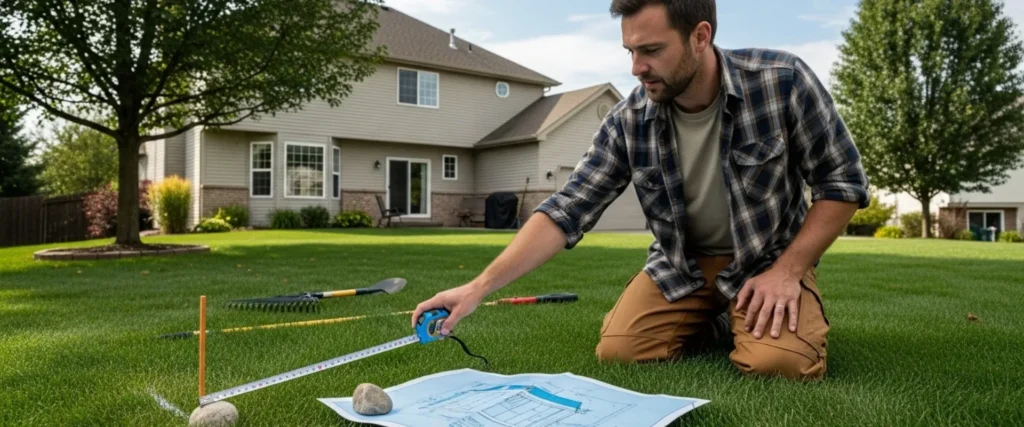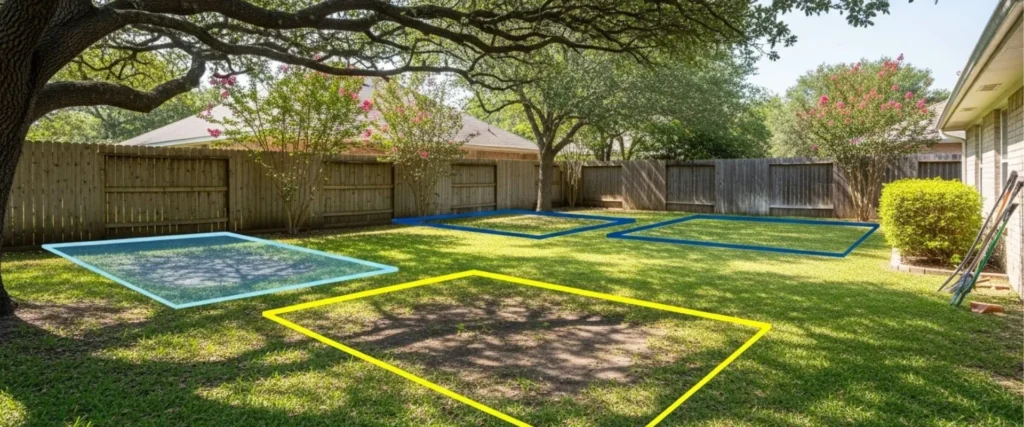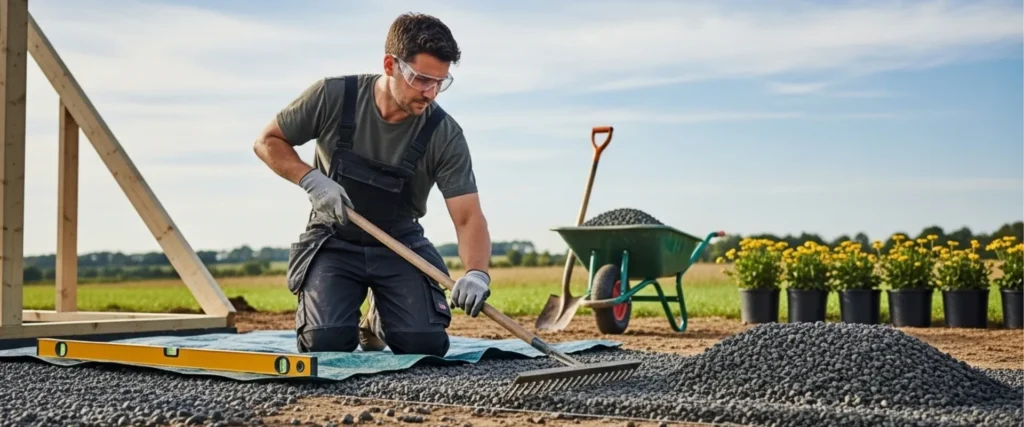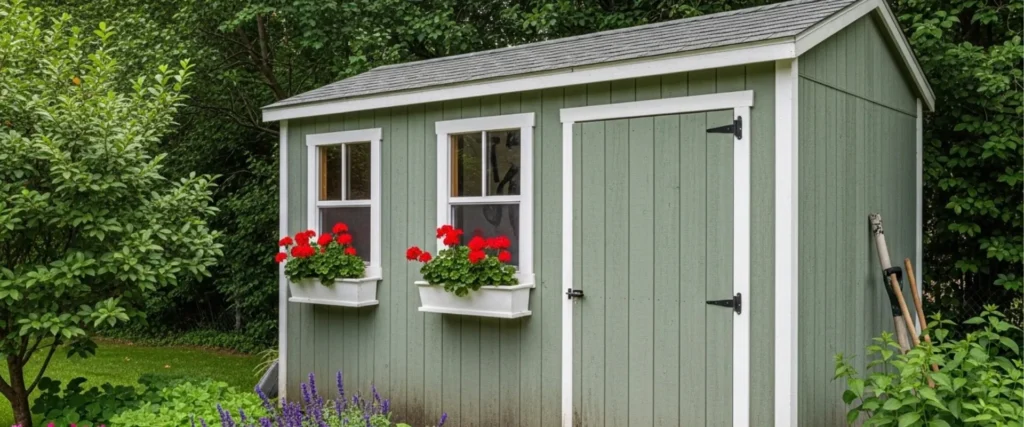Choosing the right spot for your backyard shed can make the difference between a functional storage solution and a costly mistake. The location affects everything from accessibility and drainage to local building codes and long-term maintenance. Whether you’re planning to store garden tools, lawn equipment, or seasonal items, proper shed placement requires careful consideration of multiple factors.
At Wood Kingdom West, we’ve helped Long Island homeowners find the perfect shed solutions for over 35 years. Through decades of experience, we’ve learned that taking time to evaluate your property before installation saves money and prevents headaches down the road. This guide will walk you through the essential factors to consider when selecting the ideal location for your new storage shed.


1. Assess Your Property’s Layout and Accessibility
Start by walking around your property with a measuring tape and notepad. Look for flat, stable areas that can accommodate your shed’s footprint while leaving adequate space for doors to open fully. Consider how you’ll use the shed daily; if you’re storing lawn equipment, you’ll want easy access from your garage or house.
Think about the path from your shed to where you’ll use the stored items most frequently. A shed placed too far from your garden makes it inconvenient to grab tools, while one located too close to your house might violate local setback requirements.
Make note of existing structures, trees, and landscaping features that could impact placement. Large trees provide natural shade but may drop branches or leaves that require regular cleanup. Underground utilities, septic systems, and irrigation lines also limit your placement options.
2. Evaluate Drainage and Ground Conditions
Poor drainage is one of the biggest threats to your backyard shed’s longevity. Water pooling around your shed’s foundation leads to rot, mold, and structural damage that can be expensive to repair.
Walk your property during and after rainfall to identify natural water flow patterns. Avoid low-lying areas where water naturally collects, even if they seem convenient. Instead, look for naturally elevated spots or gentle slopes that allow water to flow away from the structure.
Test soil conditions by digging a small hole about 12 inches deep in potential locations. Clay-heavy soil retains moisture longer and may require additional drainage solutions. Sandy soil drains well but may need stabilization for heavier sheds.
If your ideal location has minor drainage issues, these can often be addressed through proper site preparation. French drains, gravel foundations, or slight grading adjustments can redirect water flow effectively.


3. Consider Sunlight and Weather Exposure
The amount of sunlight your shed receives affects both its contents and structure. South-facing locations receive the most direct sunlight throughout the day, which can cause excessive heat buildup inside the shed and fade stored items.
North-facing locations receive minimal direct sunlight, keeping the interior cooler but potentially creating moisture problems in humid climates. East and west exposures offer moderate sunlight with morning or afternoon peak temperatures.
Consider your region’s prevailing winds when evaluating shed placement tips. In many areas, storms typically approach from specific directions. Positioning your shed to minimize wind exposure on its largest wall surfaces reduces stress during severe weather.
If you plan to store temperature-sensitive items like paint, chemicals, or electronics, prioritize locations with natural shade or consider adding shade structures. Alternatively, if you’re storing items that benefit from staying dry, morning sunlight can help evaporate overnight moisture.


4. Check Local Building Codes and Setback Requirements
Before finalizing your location choice, research local building codes and homeowner association rules that govern shed placement. Most municipalities require sheds to be set back a minimum distance from property lines, typically between 3 and 10 feet.
Height restrictions may also influence your shed choice and placement. Some areas limit accessory structures to specific heights or require additional permits for larger buildings.
Check if your planned location requires building permits. While many small sheds don’t need permits, larger structures or those with electrical connections often do. Starting the permit process early prevents delays and ensures your shed meets all legal requirements.
Contact your utility company to mark underground lines before beginning any excavation work. This free service prevents dangerous accidents and costly utility repairs during shed site preparation.
5. Plan for Future Landscaping and Property Changes
Think beyond your current needs when selecting your shed location. Consider how your landscaping, family situation, or property use might change over the next 10-15 years.
If you’re planning to add a pool, expand your deck, or plant large trees, ensure your shed placement won’t interfere with these future projects. Similarly, consider how growing trees or shrubs might affect access or sunlight exposure over time.
Young children may eventually want play areas where you’re considering shed placement. Elderly family members might need closer access to storage in later years. Planning for these possibilities now saves relocation costs later.
6. Site Preparation Essentials
Once you’ve chosen the perfect location, proper shed site preparation ensures your shed’s stability and longevity. Start by clearing the area of grass, weeds, and debris, extending about two feet beyond the shed’s footprint on all sides.
Level the ground using a transit level or smartphone app designed for construction. Most sheds require the foundation to be level within 1 inch across the entire footprint. This may require adding or removing soil in specific areas.
Consider your foundation options based on shed size and local conditions. Concrete pads provide the most stable foundation but require more time and expense. Gravel pads offer good drainage and easier installation. Pressure-treated lumber foundations work well for smaller sheds on stable ground.
Install proper drainage around the foundation if needed. This might include extending downspouts, installing French drains, or creating swales to direct water away from the structure.


7. Maximize Your Shed’s Potential
The right shed placement not only boosts your property’s functionality but also supports better shed organization for all your tools, equipment, and seasonal items. Our team at Wood Kingdom West provides custom shed storage solutions tailored to Long Island’s climate and property layouts.
If you’re interested in exploring backyard shed ideas or need help selecting the perfect shed for your property, Wood Kingdom West offers custom storage solutions designed for Long Island’s unique climate and conditions. Our experienced team can help you navigate local requirements and ensure proper installation.
Transform Your Storage Solution Today
Choosing the best location for your backyard shed requires balancing practical considerations with your property’s unique characteristics. By evaluating drainage, accessibility, building codes, and long-term needs, you’ll create a functional storage solution that serves your family for years to come.
Ready to explore your options? Contact Wood Kingdom West to discuss custom shed solutions perfect for your Long Island property. Our team brings over three decades of experience helping homeowners create organized, functional outdoor spaces.
Frequently Asked Questions
How far should a shed be from the house?
Most local codes require sheds to be at least 3-5 feet from the house, but check your specific municipal requirements. Consider practical factors like access and aesthetics when determining the exact distance.
Can I place a shed under trees?
While possible, placing a shed directly under large trees increases maintenance needs due to falling branches and leaves. Ensure adequate clearance, and consider how root systems might affect the foundation.
Do I need a concrete pad for my shed?
Concrete pads aren’t always necessary. Smaller sheds can use gravel or treated lumber foundations. Larger sheds or those storing heavy equipment benefit from concrete foundations.
How can I determine if my soil drains sufficiently?
Dig a 12-inch deep hole and fill it with water. If water remains after 24 hours, you may have drainage issues that need addressing before shed installation.
What if my ideal location has a slight slope?
Minor slopes can be leveled during site preparation. Significant slopes may require retaining walls or terracing, which increases installation complexity and cost.

